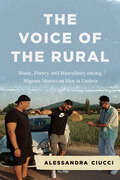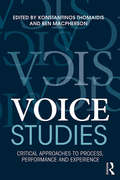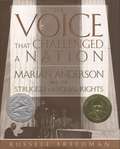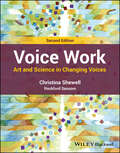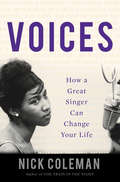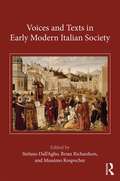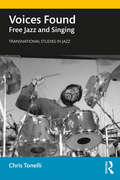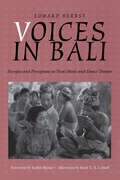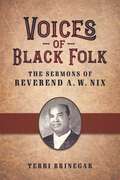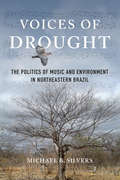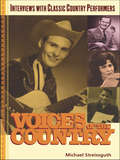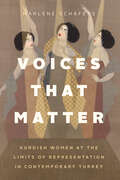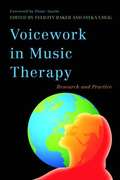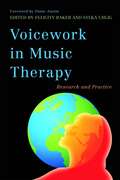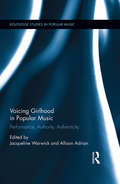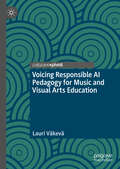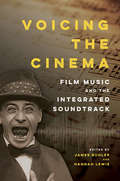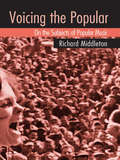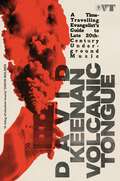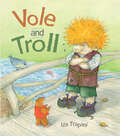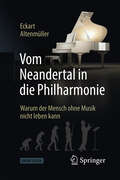- Table View
- List View
The Voice of the Rural: Music, Poetry, and Masculinity among Migrant Moroccan Men in Umbria (Chicago Studies in Ethnomusicology)
by Alessandra CiucciA moving portrait of the contemporary experiences of migrant Moroccan men. Umbria is known to most Americans for its picturesque rolling hills and medieval villages, but to the many migrant Moroccan men who travel there, Umbria is better known for the tobacco fields, construction sites, small industries, and the outdoor weekly markets where they work. Marginalized and far from their homes, these men turn to Moroccan traditions of music and poetry that evoke the countryside they have left— l-‘arubiya, or the rural. In this book, Alessandra Ciucci takes us inside the lives of Moroccan workers, unpacking the way they share a particular musical style of the rural to create a sense of home and belonging in a foreign and inhospitable nation. Along the way, she uncovers how this culture of belonging is not just the product of the struggles of migration, but also tied to the reclamation of a noble and virtuous masculine identity that is inaccessible to Moroccan migrants in Italy. The Voice of the Rural allows us to understand the contemporary experiences of migrant Moroccan men by examining their imagined relationship to the rural through sound, shedding new light on the urgent issues of migration and belonging.
The Voice of the Rural: Music, Poetry, and Masculinity among Migrant Moroccan Men in Umbria (Chicago Studies in Ethnomusicology)
by Alessandra CiucciA moving portrait of the contemporary experiences of migrant Moroccan men. Umbria is known to most Americans for its picturesque rolling hills and medieval villages, but to the many migrant Moroccan men who travel there, Umbria is better known for the tobacco fields, construction sites, small industries, and the outdoor weekly markets where they work. Marginalized and far from their homes, these men turn to Moroccan traditions of music and poetry that evoke the countryside they have left— l-‘arubiya, or the rural. In this book, Alessandra Ciucci takes us inside the lives of Moroccan workers, unpacking the way they share a particular musical style of the rural to create a sense of home and belonging in a foreign and inhospitable nation. Along the way, she uncovers how this culture of belonging is not just the product of the struggles of migration, but also tied to the reclamation of a noble and virtuous masculine identity that is inaccessible to Moroccan migrants in Italy. The Voice of the Rural allows us to understand the contemporary experiences of migrant Moroccan men by examining their imagined relationship to the rural through sound, shedding new light on the urgent issues of migration and belonging.
Voice Studies: Critical Approaches to Process, Performance and Experience (Routledge Voice Studies)
by Konstantinos Thomaidis Ben MacphersonVoice Studies brings together leading international scholars and practitioners, to re-examine what voice is, what voice does, and what we mean by "voice studies" in the process and experience of performance. This dynamic and interdisciplinary publication draws on a broad range of approaches, from composing and voice teaching through to psychoanalysis and philosophy, including: voice training from the Alexander Technique to practice-as-research; operatic and extended voices in early baroque and contemporary underwater singing; voices across cultures, from site-specific choral performance in Kentish mines and Australian sound art, to the laments of Kraho Indians, Korean pansori and Javanese wayang; voice, embodiment and gender in Robertson’s 1798 production of Phantasmagoria, Cathy Berberian radio show, and Romeo Castellucci’s theatre; perceiving voice as a composer, listener, or as eavesdropper; voice, technology and mobile apps. With contributions spanning six continents, the volume considers the processes of teaching or writing for voice, the performance of voice in theatre, live art, music, and on recordings, and the experience of voice in acoustic perception and research. It concludes with a multifaceted series of short provocations that simply revisit the core question of the whole volume: what is voice studies?
The Voice That Challenged a Nation: Marian Anderson and the Struggle for Equal Rights
by Russell Freedman"A voice like yours," celebrated conductor Arturo Toscanini told contralto Marian Anderson, "is heard once in a hundred years." This insightful account of the great African American vocalist considers her life and musical career in the context of the history of civil rights in this country. Drawing on Anderson's own writings and other contemporary accounts, Russell Freedman shows readers a singer pursuing her art despite the social constraints that limited the careers of black performers in the 1920s and 1930s. Though not a crusader or a spokesperson by nature, Marian Anderson came to stand for all black artists -- and for all Americans of color -- when, with the help of such prominent figures as Eleanor Roosevelt, she gave her landmark 1939 performance on the steps of the Lincoln Memorial, which signaled the end of segregation in the arts.<P><P> Carefully researched, expertly told, and profusely illustrated with contemporary photographs, this Newbery Honor and Sibert Medal-winning book is a moving account of the life of a talented and determined artist who left her mark on musical and social history. Through her story, Newbery Medal-winning author Russell Freedman, one of today's leading authors of nonfiction for young readers, illuminates the social and political climate of the day and an important chapter in American history. Notes, bibliography, discography, index.<P> Newbery Honor book and Winner of the Sibert Medal
Voice Work: Art and Science in Changing Voices
by Christina Shewell Rockford SansomVoice Work Second Edition The voice is one of the fundamental modes of self-expression, a key touchstone of identity and sense of self. Many people in all walks of life are looking to change their voices, whether to modify a speaking challenge of some kind, to cultivate a professional skill, or for other reasons. Voice practitioners have an invaluable role in guiding clients along the path to their desired voice outcomes. Building on the success of the first edition, Voice Work continues to offer a wide-ranging introduction to the repair, improvement, development, and exploration of the spoken and sung voice. Balancing rigorous scholarship with practical insights, the book draws from all major vocal professions and paths within voice work. It offers guidance for developing the voice alongside detailed, up-to-date insights into the work of voice instruction. Readers of the second edition of Voice Work will also find: Numerous new colour illustrationsExtensive chapter revisions and reference updatesOriginal chapters on the history of voice work, public speaking and voice work onlineUpdated material on voice and emotions, mindfulness and imagery, voice work and well-being, the applications of technology and the value of practitioner supervisionAdditional techniques and exercises Voice Work is a valuable resource for spoken voice teachers, singing teachers, and speech and language therapists and pathologists. Endorsements from leading members of these professions for both the first and second editions are featured inside.
Voices: How a Great Singer Can Change Your Life
by nick Coleman"Voices isn't just illuminating and thought–provoking and clever; it is exciting." —Roddy Doyle, author of The CommitmentsA personal exploration of what singing means and how it works, Voices is a book about our deepest, most telling relationships with music. Nick Coleman examines the act of singing not as a performance, but as a close, difficult moment of hopeful connection. What does it do to us, emotionally and psychologically, to listen hard and habitually to somebody else’s singing? Why is human song so essential to our lives? The book asks many other questions, too: Why did Jagger and Lennon sing like that (and not like this)? Billie, Janis, Amy: must the voices of anguish always dissolve into spectacle? What makes us turn again and again to a singing human voice?The history of postwar popular music is often told sociologically or in terms of musicological influence and innovation in style. Voices offers a different, intimate perspective. In ten discrete but cohering essays, Coleman tackles the arc of that history as an emotional experience with real psychological consequences. He writes about the voices that have affected the ways he feels about and understands the world—from Aretha Franklin to Amy Winehouse, Marvin Gaye to David Bowie. Ultimately, Voices is the story of what it is to listen and be moved—what it is to feel emotion.
Voices and Texts in Early Modern Italian Society
by Stefano Dall’Aglio Brian Richardson Massimo RospocherThis book studies the uses of orality in Italian society, across all classes, from the fifteenth to the seventeenth century, with an emphasis on the interrelationships between oral communication and the written word. The Introduction provides an overview of the topic as a whole and links the chapters together. Part 1 concerns public life in the states of northern, central, and southern Italy. The chapters examine a range of performances that used the spoken word or song: concerted shouts that expressed the feelings of the lower classes and were then recorded in writing; the proclamation of state policy by town criers; songs that gave news of executions; the exercise of power relations in society as recorded in trial records; and diplomatic orations and interactions. Part 2 centres on private entertainments. It considers the practices of the performance of poetry sung in social gatherings and on stage with and without improvisation; the extent to which lyric poets anticipated the singing of their verse and collaborated with composers; performances of comedies given as dinner entertainments for the governing body of republican Florence; and a reading of a prose work in a house in Venice, subsequently made famous through a printed account. Part 3 concerns collective religious practices. Its chapters study sermons in their own right and in relation to written texts, the battle to control spaces for public performance by civic and religious authorities, and singing texts in sacred spaces.
Voices Found: Free Jazz and Singing
by Chris TonelliVoices Found: Free Jazz and Singing contributes to a wave of voice studies scholarship with the first book-length study of free jazz voice. It pieces together a history of free jazz voice that spans from sound poetry and scat in the 1950s to the more recent wave of free jazz choirs. The author traces the developments and offers a theory, derived from interviews with many of the most important singers in the history of free jazz voice, of how listeners have experienced and evaluated the often unconventional vocal sounds these vocalists employed. This theory explains that even audiences willing to enjoy harsh sounds from saxophones or guitars often resist when voices make sounds that audiences understand as not-human. Experimental poetry and scat were combined and transformed in free jazz spaces in the 1960s and 1970s by vocalists like Yoko Ono (in solo work and her work with Ornette Coleman and John Stevens), Jeanne Lee (in her solo work and her work with Archie Shepp and Gunter Hampel), Leon Thomas (in his solo work as well as his work with Pharoah Sanders and Carlos Santana), and Phil Minton and Maggie Nicols (who devoted much of their energy to creating unaccompanied free jazz vocal music). By studying free jazz voice we can learn important lessons about what we expect from the voice and what happens when those expectations are violated. This book doesn't only trace histories of free jazz voice, it makes an attempt to understand why this story hasn't been told before, with an impressive breadth of scope in terms of the artists covered, drawing on research from the US, Canada, Wales, Scotland, France, The Netherlands, and Japan.
Voices in Bali: Energies and Perceptions in Vocal Music and Dance Theater (Music Culture)
by Rene T. Lysloff Edward Herbst Judith BeckerA scholar and trained performer of Balinese vocal music and dance, ethnomusicologist Edward Herbst brings unique talents to bear in this provocative book. The lessons of his Balinese masters enable him to offer fresh insight to this culture's aesthetics and cultural elements. Appropriating John Cage's effective style of "mixing theory, anecdote, context, philosophy, and humor," Herbst crafts an accessible body of work, compelling in substance and form. By merging the "Balinese concept of place-time-context with Cage's concepts of structure, method, and form, [Herbst] returns to the critical issue of what scholars and intercultural artists are doing, and 'what' is their 'object' under study." Undergraduates and scholars in fields as varied as theater studies and anthropology will find this book and companion CD (in print editions) an important resource not only for its knowledgeable treatment of Balinese culture, but as an example of a more personal and engaging style of scholarly discourse. The ebook edition includes embedded audio.
Voices of Black Folk: The Sermons of Reverend A. W. Nix (American Made Music Series)
by Terri BrinegarRecipient of a 2023 Certificate of Merit for Best Historical Research in Recorded Blues, R&B, Gospel, Hip Hop, or Soul Music from the Association for Recorded Sound CollectionsIn the late 1920s, Reverend A. W. Nix (1880–1949), an African American Baptist minister born in Texas, made fifty-four commercial recordings of his sermons on phonographs in Chicago. On these recordings, Nix presented vocal traditions and styles long associated with the southern, rural Black church as he preached about self-help, racial uplift, thrift, and Christian values. As southerners like Nix fled into cities in the North to escape the rampant racism in the South, they contested whether or not African American vocal styles of singing and preaching that had emerged during the slavery era were appropriate for uplifting the race. Specific vocal characteristics, like those on Nix’s recordings, were linked to the image of the “Old Negro” by many African American leaders who favored adopting Europeanized vocal characteristics and musical repertoires into African American churches in order to uplift the modern “New Negro” citizen. Through interviews with family members, musical analyses of the sounds on Nix’s recordings, and examination of historical documents and relevant scholarship, Terri Brinegar argues that the development of the phonograph in the 1920s afforded preachers like Nix the opportunity to present traditional Black vocal styles of the southern Black church as modern Black voices. These vocal styles also influenced musical styles. The “moaning voice” used by Nix and other ministers was a direct connection to the “blues moan” employed by many blues singers including Blind Willie, Blind Lemon, and Ma Rainey. Both Reverend A. W. Nix and his brother, W. M. Nix, were an influence on the “Father of Gospel Music,” Thomas A. Dorsey. The success of Nix’s recorded sermons demonstrates the enduring values African Americans placed on traditional vocal practices.
Voices of Drought: The Politics of Music and Environment in Northeastern Brazil
by Michael B. SilversIn Voices of Drought, Michael B. Silvers proposes a scholarship focused on environmental justice to understand key questions in the study of music and the environment. His ecomusicological perspective offers a fascinating approach to events in Ceará, a northeastern Brazilian state affected by devastating droughts. These crises have a profound impact on social difference and stratification, and thus on forró music in the sertão (backlands) of the region. At the same time, the complex interactions of popular music and social conditions also help create the environment. Silvers offers case studies focused on the sertão that range from the Brazilian wax harvested in Ceará for use in early wax cylinder sound recordings to the drought- and austerity-related cancelation of Carnival celebrations in 2014-16. Unearthing links between music and the environmental and social costs of drought, his daring synthesis explores ecological exile, poverty, and unequal access to water resources alongside issues like corruption, prejudice, unbridled capitalism, and expanding neoliberalism.
Voices of the Country: Interviews with Classic Country Performers
by Michael Streissguth"Voices of the Country" presents interviews with innovative musicians, producers, and songwriters who shaped the last fifty years of country music. From Eddy Arnold's new, smoother approach to song delivery to Loretta Lynn's take-no-prisoners feminism, these people opened new vistas in country music - and American culture. Streissguth is a sensitive and knowledgeable interviewer: he gets beyond the standard publicity tales to the heart of the real voice - and real experiences - of these important figures.
Voices That Matter: Kurdish Women at the Limits of Representation in Contemporary Turkey
by Marlene SchäfersA fine-grained ethnography exploring the sociopolitical power of Kurdish women’s voices in contemporary Turkey. “Raise your voice!” and “Speak up!” are familiar refrains that assume, all too easily, that gaining voice will lead to empowerment, healing, and inclusion for marginalized subjects. Marlene Schäfers’s Voices That Matter reveals where such assumptions fall short, demonstrating that “raising one’s voice” is no straightforward path to emancipation but fraught with anxieties, dilemmas, and contradictions. In its attention to the voice as form, this book examines not only what voices say but also how they do so, focusing on Kurdish contexts where oral genres have a long, rich legacy. Examining the social labor that voices carry out as they sound, speak, and resonate, Schäfers shows that where new vocal practices arise, they produce new selves and practices of social relations. In Turkey, recent decades have seen Kurdish voices gain increasing moral and political value as metaphors of representation and resistance. Women’s voices, in particular, are understood as potent means to withstand patriarchal restrictions and political oppression. By ethnographically tracing the transformations in how Kurdish women relate to and employ their voices as a result of these shifts, Schäfers illustrates how contemporary politics foster not only new hopes and desires but also create novel vulnerabilities as they valorize, elicit, and discipline voice in the name of empowerment and liberation.
Voices That Matter: Kurdish Women at the Limits of Representation in Contemporary Turkey (Mersion: Emergent Village Resources For Communities Of Faith Ser.)
by Marlene SchäfersA fine-grained ethnography exploring the sociopolitical power of Kurdish women’s voices in contemporary Turkey. “Raise your voice!” and “Speak up!” are familiar refrains that assume, all too easily, that gaining voice will lead to empowerment, healing, and inclusion for marginalized subjects. Marlene Schäfers’s Voices That Matter reveals where such assumptions fall short, demonstrating that “raising one’s voice” is no straightforward path to emancipation but fraught with anxieties, dilemmas, and contradictions. In its attention to the voice as form, this book examines not only what voices say but also how they do so, focusing on Kurdish contexts where oral genres have a long, rich legacy. Examining the social labor that voices carry out as they sound, speak, and resonate, Schäfers shows that where new vocal practices arise, they produce new selves and practices of social relations. In Turkey, recent decades have seen Kurdish voices gain increasing moral and political value as metaphors of representation and resistance. Women’s voices, in particular, are understood as potent means to withstand patriarchal restrictions and political oppression. By ethnographically tracing the transformations in how Kurdish women relate to and employ their voices as a result of these shifts, Schäfers illustrates how contemporary politics foster not only new hopes and desires but also create novel vulnerabilities as they valorize, elicit, and discipline voice in the name of empowerment and liberation.
Voices That Matter: Kurdish Women at the Limits of Representation in Contemporary Turkey
by Marlene SchäfersA fine-grained ethnography exploring the sociopolitical power of Kurdish women’s voices in contemporary Turkey. “Raise your voice!” and “Speak up!” are familiar refrains that assume, all too easily, that gaining voice will lead to empowerment, healing, and inclusion for marginalized subjects. Marlene Schäfers’s Voices That Matter reveals where such assumptions fall short, demonstrating that “raising one’s voice” is no straightforward path to emancipation but fraught with anxieties, dilemmas, and contradictions. In its attention to the voice as form, this book examines not only what voices say but also how they do so, focusing on Kurdish contexts where oral genres have a long, rich legacy. Examining the social labor that voices carry out as they sound, speak, and resonate, Schäfers shows that where new vocal practices arise, they produce new selves and practices of social relations. In Turkey, recent decades have seen Kurdish voices gain increasing moral and political value as metaphors of representation and resistance. Women’s voices, in particular, are understood as potent means to withstand patriarchal restrictions and political oppression. By ethnographically tracing the transformations in how Kurdish women relate to and employ their voices as a result of these shifts, Schäfers illustrates how contemporary politics foster not only new hopes and desires but also create novel vulnerabilities as they valorize, elicit, and discipline voice in the name of empowerment and liberation.
Voicework in Music Therapy: Research and Practice
by Felicity Baker Sylka Uhlig Diane AustinThe authors bring together 16 chapters by a group of music therapy voicework specialists from North America, Europe, Asia, and Australia who describe to music therapy students, practitioners, and researchers voicework techniques for clients of all ages. They explain structured and free approaches to voicework with autistic and at-risk children; adults who were told as children they could not sing; newborns; individuals with emotional trauma, dementia, spinal cord injury, traumatic brain injury, neurological damage, Parkinson's disease, and aphasia or apraxia; and those in hospice or palliative care. Annotation ©2012 Book News, Inc. , Portland, OR (booknews. com)
Voicework in Music Therapy
by Sylka Uhlig Edited by Felicity BakerThe voice is a powerful instrument in music therapy practice and this anthology of voicework techniques explores everything the practitioner and researcher needs to know in order to bring about successful vocal interventions across a broad range of client groups. Compiling a wealth of international evidence-based practice, this book offers detailed descriptions of clinical methods that are grounded in research. Chapters are grouped into structured and unstructured approaches for use with clients of all ages. Clinical populations covered include neonates, children with autism or developmental disability, individuals with neurological damage including stroke, Parkinson's disease patients, traumatic brain injury, and spinal injury, people with mental illness, medical conditions such as asthma and pain, oncology and palliative care, aged care and dementia. This book will be an invaluable resource for any music therapy student, practitioner or researcher looking to explore the use of voicework in music therapy.
Voicing Girlhood in Popular Music: Performance, Authority, Authenticity (Routledge Studies in Popular Music)
by Jacqueline Warwick Allison AdrianThis interdisciplinary volume explores the girl’s voice and the construction of girlhood in contemporary popular music, visiting girls as musicians, activists, and performers through topics that range from female vocal development during adolescence to girls’ online media culture. While girls’ voices are more prominent than ever in popular music culture, the specific sonic character of the young female voice is routinely denied authority. Decades old clichés of girls as frivolous, silly, and deserving of contempt prevail in mainstream popular image and sound. Nevertheless, girls find ways to raise their voices and make themselves heard. This volume explores the contemporary girl’s voice to illuminate the way ideals of girlhood are historically specific, and the way adults frame and construct girlhood to both valorize and vilify girls and women. Interrogating popular music, childhood, and gender, it analyzes the history of the all-girl band from the Runaways to the present; the changing anatomy of a girl’s voice throughout adolescence; girl’s participatory culture via youtube and rock camps, and representations of the girl’s voice in other media like audiobooks, film, and television. Essays consider girl performers like Jackie Evancho and Lorde, and all-girl bands like Sleater Kinney, The Slits and Warpaint, as well as performative 'girlishness' in the voices of female vocalists like Joni Mitchell, Beyoncé, Miley Cyrus, Taylor Swift, Kathleen Hanna, and Rebecca Black. Participating in girl studies within and beyond the field of music, this book unites scholarly perspectives from disciplines such as musicology, ethnomusicology, comparative literature, women’s and gender studies, media studies, and education to investigate the importance of girls’ voices in popular music, and to help unravel the complexities bound up in music and girlhood in the contemporary contexts of North America and the United Kingdom.
Voicing Responsible AI Pedagogy for Music and Visual Arts Education
by Lauri VäkeväThis book critically examines the integration of generative artificial intelligence (Gen AI) in music education, exploring its transformative potential and associated risks. It underscores the necessity for innovative AI pedagogies across music and the arts, offering educators, researchers, and policymakers valuable insights for incorporating Gen AI into teaching while mitigating its hazards. By adopting a balanced critical perspective, the book aims to promote a dynamic, inclusive, and responsible educational approach that is responsive to the rapid advancements in adaptive technology. The book's argumentation is grounded in synthesizing Deweyan pragmatist and Baradian posthumanist philosophical perspectives. These perspectives collectively provide a framework for addressing the deployment of Gen AI in music education within a broader ethical context of global sustainability. The book is also informed by the author's many years as a scholar of music education.
Voicing the Cinema: Film Music and the Integrated Soundtrack
by James Buhler Hannah LewisTheorists of the soundtrack have helped us understand how the voice and music in the cinema impact a spectator's experience. James Buhler and Hannah Lewis edit in-depth essays from many of film music's most influential scholars in order to explore fascinating issues around vococentrism, the voice in cinema, and music’s role in the integrated soundtrack. The collection is divided into four sections. The first explores historical approaches to technology in the silent film, French cinema during the transition era, the films of the so-called New Hollywood, and the post-production sound business. The second investigates the practice of the singing voice in diverse repertories such as Bergman's films, Eighties teen films, and girls' voices in Brave and Frozen. The third considers the auteuristic voice of the soundtrack in works by Kurosawa, Weir, and others. A last section on narrative and vococentrism moves from The Martian and horror film to the importance of background music and the state of the soundtrack at the end of vococentrism. Contributors: Julie Brown, James Buhler, Marcia Citron, Eric Dienstfrey, Erik Heine, Julie Hubbert, Hannah Lewis, Brooke McCorkle, Cari McDonnell, David Neumeyer, Nathan Platte, Katie Quanz, Jeff Smith, Janet Staiger, and Robynn Stilwell
Voicing the Popular: On the Subjects of Popular Music
by Richard MiddletonHow does popular music produce its subject? How does it produce us as subjects? More specifically, how does it do this through voice--through "giving voice"? And how should we understand this subject--"the people"--that it voices into existence? Is it singular or plural? What is its history and what is its future? Voicing the Popular draws on approaches from musical interpretation, cultural history, social theory and psychoanalysis to explore key topics in the field, including race, gender, authenticity and repetition. Taking most of his examples from across the past hundred years of popular music development--but relating them to the eighteenth- and nineteenth-century "pre-history"--Richard Middleton constructs an argument that relates "the popular" to the unfolding of modernity itself. Voicing the Popular renews the case for ambitious theory in musical and cultural studies, and, against the grain of much contemporary thought, insists on the progressive potential of a politics of the Low.
Volcanic Tongue: A Time-Travelling Evangelist’s Guide to Late 20th-Century Underground Music
by David KeenanVolcanic Tongue presents the first ever collection of multi-award-winning author David Keenan's music writings. Keenan has been writing about music since publishing his first fanzine, inspired by The Pastels and by Glasgow (and Airdrie's) DIY music scene, in 1988. Since then, he has written about music for Melody Maker, NME, Uncut, Mojo, The New York Times, Ugly Things, The Literary Review, The Social and, most consistently, The Wire. Volcanic Tongue was also the name of the record shop and mail order that Keenan ran with his partner, Heather Leigh, in Glasgow from 2005-2015.Volcanic Tongue features the best of his reviews, interviews and think pieces, with exclusive in-depth conversations between Keenan and Nick Cave, members of legendary industrial bands Coil and Throbbing Gristle, krautrock legends like Faust, Shirley Collins, the first lady of English folk, Kevin Shields of My Bloody Valentine, German auto-destructives Einstürzende Neubauten, as well as discographical analysis of the back catalogues of groups like Sonic Youth and musicians like John Fahey, extensive writings on free jazz and obsessive in-depth digs into favourites like Pere Ubu, Metal Box-era Public Image Ltd, Sun Ra, guitarist and vocalist John Martyn and many more. It is an essential addition to any music fan's bookshelf.This first collection of his legendary criticism functions as an extended love letter to the revolutionary music of the 20th century and the incredible culture that sustained it.
Volcanic Tongue: A Time-Travelling Evangelist’s Guide to Late 20th-Century Underground Music
by David KeenanVolcanic Tongue presents the first ever collection of multi-award-winning author David Keenan's music writings. Keenan has been writing about music since publishing his first fanzine, inspired by The Pastels and by Glasgow (and Airdrie's) DIY music scene, in 1988. Since then, he has written about music for Melody Maker, NME, Uncut, Mojo, The New York Times, Ugly Things, The Literary Review, The Social and, most consistently, The Wire. Volcanic Tongue was also the name of the record shop and mail order that Keenan ran with his partner, Heather Leigh, in Glasgow from 2005-2015.Volcanic Tongue features the best of his reviews, interviews and think pieces, with exclusive in-depth conversations between Keenan and Nick Cave, members of legendary industrial bands Coil and Throbbing Gristle, krautrock legends like Faust, Shirley Collins, the first lady of English folk, Kevin Shields of My Bloody Valentine, German auto-destructives Einstürzende Neubauten, as well as discographical analysis of the back catalogues of groups like Sonic Youth and musicians like John Fahey, extensive writings on free jazz and obsessive in-depth digs into favourites like Pere Ubu, Metal Box-era Public Image Ltd, Sun Ra, guitarist and vocalist John Martyn and many more. It is an essential addition to any music fan's bookshelf.This first collection of his legendary criticism functions as an extended love letter to the revolutionary music of the 20th century and the incredible culture that sustained it.
Vole and Troll
by Iza TrapaniLoosely based on "The Three Billy Goats Gruff," this sweet, funny tale introduces two loveable characters who just can't get along . . . until they start singing.Troll-dee-roll, I'm a troll, and my favorite food is vole.Meet mischievous Vole and grouchy old Troll, the newest characters by best selling author/illustrator Iza Trapani. Vole wants to cross the bridge to where the literal and proverbial grass is greener, but grumpy old Troll lives under the bridge and offers two options: pay the toll or eat Vole. Vole outwits Troll three times by distracting him with clever, interactive songs (which will be quite familiar to young children and caregivers). But in the end, the pair lays aside their differences and embraces their common love of music.
Vom Neandertal in die Philharmonie: Warum der Mensch ohne Musik nicht leben kann
by Eckart AltenmüllerWarum haben wir Menschen Musik? Wie entfaltet Musik ihre Wirkung? Was geht dabei in unserem Gehirn vor? Fördert Musik die Intelligenz? Dient sie dem Gruppenzusammenhalt? Teilt Musik Emotionen mit? Dieses Buch erklärt die zahlreichen Wirkungen von Musik auf Fühlen und Denken, auf die Organisation von Gruppen sowie auf unsere körperliche und geistige Gesundheit. Im ersten Teil des Werkes werden die evolutionären Grundlagen der Musikwahrnehmung und des Musizierens dargestellt. Die faszinierenden neuen Erkenntnisse zu den positiven, aber auch den negativen Auswirkungen intensiven Musizierens auf das Nervensystem werden in den folgenden Kapiteln geschildert. Glücklicherweise macht Musik nur selten krank – viel wichtiger sind die bislang noch gar nicht ausgeschöpften heilenden Potenziale und die große Macht der positiven Emotionen, die durch Musik ausgelöst werden. Mit diesen erfreulichen und zukunftsweisenden Aspekten schließt das Buch, das jeden ansprechen wird, der eine Liebe zur Musik empfindet, sei es als Musizierender oder als Hörer.
